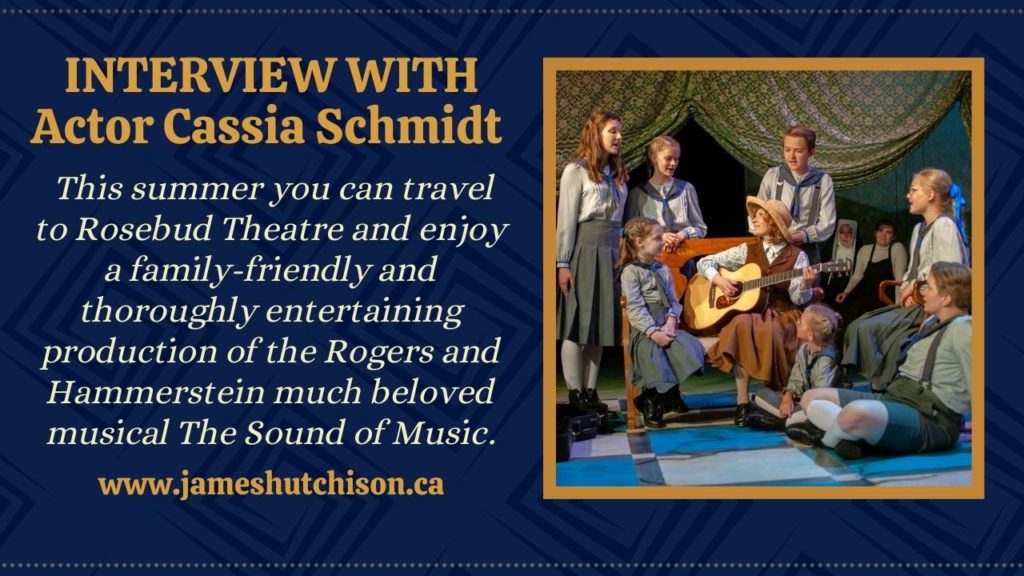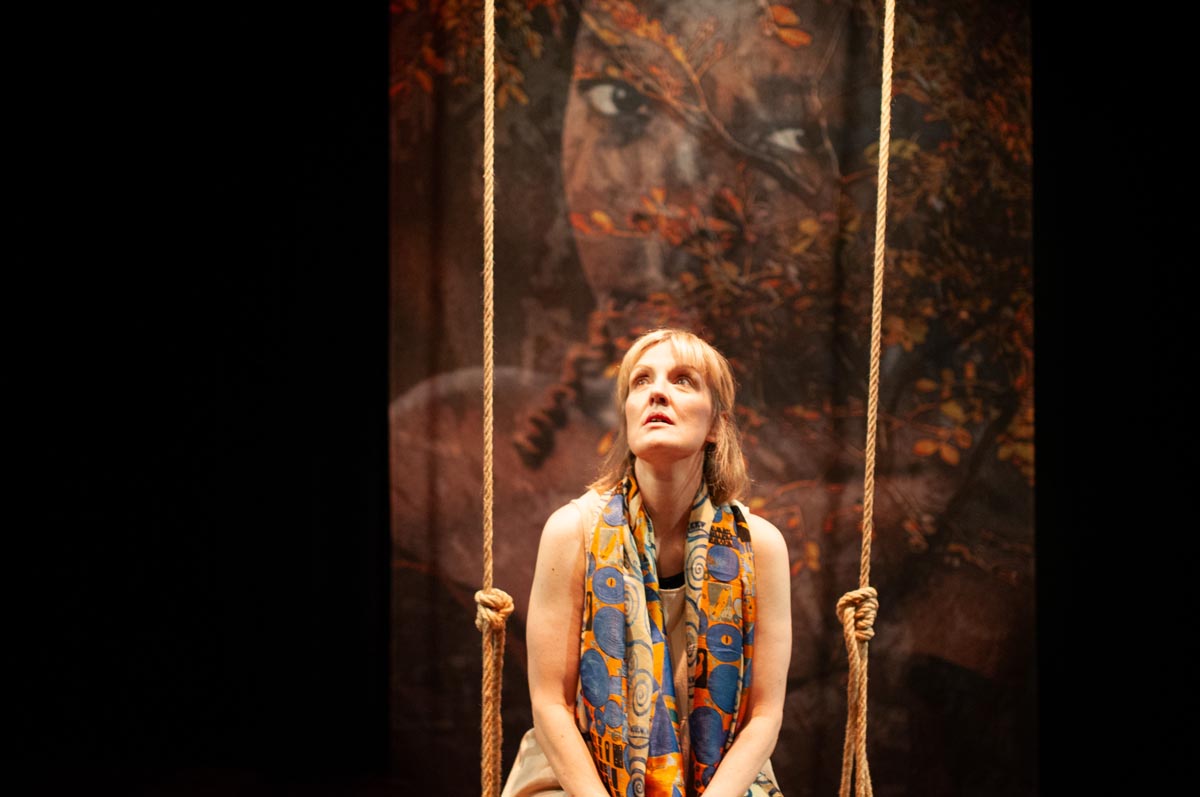
The stage lets us travel to other times and places and this summer Rosebud Theatre is taking audiences on a journey to South Africa during the time of Apartheid in Pamela Gien’s 2001 Obie Award-winning play The Syringa Tree. Apartheid was an institutionalized system of legalized racial segregation between South Africa’s white minority and nonwhite majority that existed from 1948 until the early 1990s.
Katharine Venour plays twenty-two different characters in a one-woman show that tells a story about two families – one white and one black – caught in the grips of a system where the colour of your skin determines your place and opportunities in South African society. The primary narrator of the story is Elizabeth the six-year-old white daughter of Isaac her Jewish father and Eugenie her Catholic mother. In the play her nanny Salamina secretly gives birth to a daughter she names Moliseng. Elizabeth’s family and Salamina’s family are forced to hide and protect Moliseng from the authorities and other members of the community. Although the story contains tragic events the play ultimately delivers a message of love and hope.
The Syringa Tree is a powerful story told on an intimate stage in a brilliantly directed production by Morris Ertman that mixes a simple set with sound and lights to create a world where Katharine Venour delivers a compelling and deeply moving performance. I contacted Katharine after seeing the show to ask her some questions about her approach to acting as well as questions about the play including how seeing the story through the eyes of a child impacts how the story is told.
JAMES HUTCHISON
What do we mean when we say that an actor’s job is to serve the story?
KATHARINE VENOUR
I think the story is the most important part of the theatre experience. The story is everything. And the actor’s job is to speak the story, speak the words as truthfully and powerfully and clearly as possible and to bring that story to life for an audience.
Most professional actors go through a 4-year training program – either at a university or an acting school – to train their bodies, voices, hearts, and minds to become good instruments in the telling of story. As an actor, my goal is to be the best storyteller that I can be.
I believe that an actor is engaged in an act of service when she takes on a role. You are serving something bigger than you. Your job is to lift up and embody the words and character and vision that the playwright has created for you on the page. The playwright has woven a world, and as an actor I need to figure how I fit into the world and vision of the playwright.
Words are at the heart of the theatre and they can be the conveyors of truth and beauty. I want to speak those words in a truthful and compelling way for an audience, and that takes technique and imagination and inspiration. These are tools that an actor learns and hones in an acting program and throughout one’s career.
Many actors continue to take workshops with master teachers throughout their careers to continue to grow and improve as artists. It’s a life-long craft and process that requires humility and courage. For me, the best way I take it on is to know that it’s bigger than me. That makes the work meaningful.
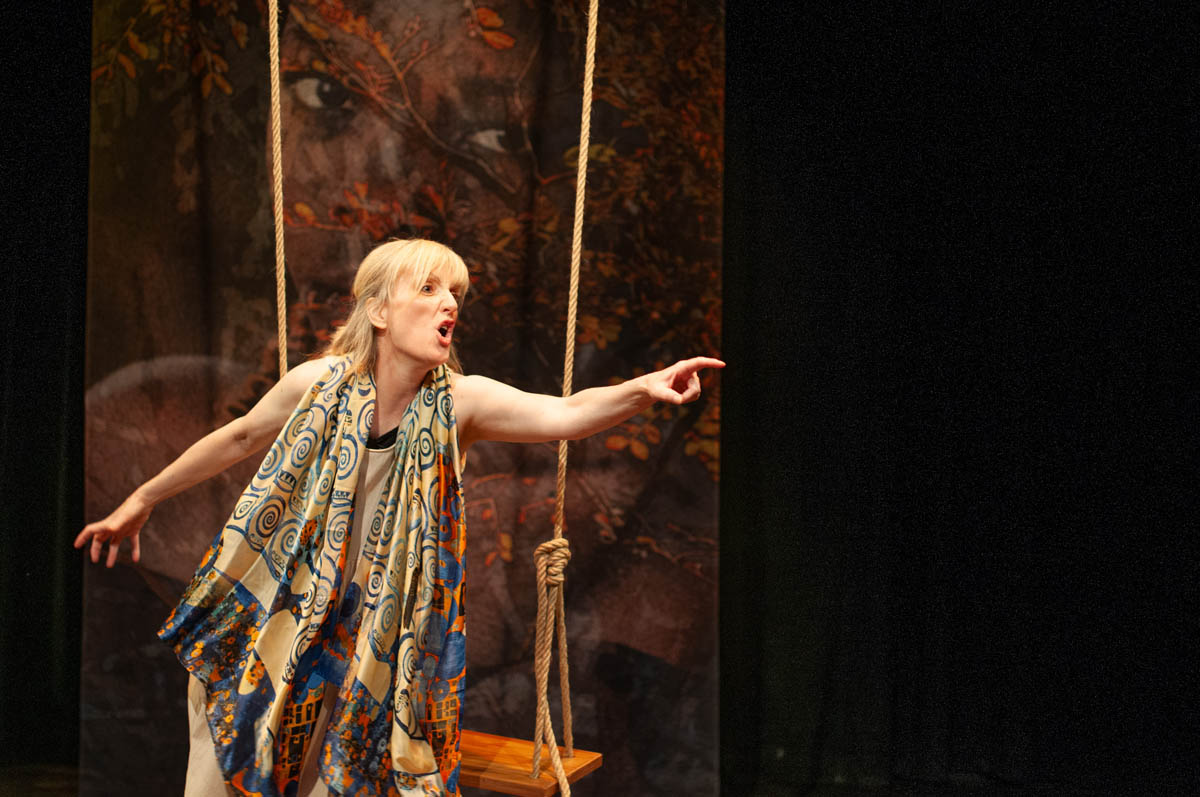
JAMES
How much do you think an actor’s performance is based on analysis and reason and how much do you think is based on instinct? Or maybe how do those two things mix when you’re working on a part?
KATHARINE
Yes, this is a great question. I think critical analytical skills in reading a play as well as instinct and gut response are all valuable and crucial for me as an actor.
During my acting training at the University of Calgary, acting students were required to take courses on theatre history where we read three plays a week and analyzed them. I think this was great for me as an actor – and also coincided with my love for literature which I continued in my graduate literature studies at UBC – so I loved it.
I think learning about themes, imagery, character relationships, conflict and the overall structure of a play – as varied as that can be – is so helpful to me as an actor and fires up my imagination and helps me to understand the vision of a playwright and then the director and how I can bring the character I play to life.
But instinct and that gut reaction and the way a play calls to you as an actor are also powerful tools for the actor. For me, I have to feel a heart connection to a story. And I don’t really know how to explain that except that I feel like I want to be part of the story. I want to be a part of speaking it into the world because it is meaningful to me and I connect emotionally or spiritually to it. And in the acting moment on stage, you learn as an actor how to follow your instincts for playing a scene or a moment. For me, the physicality of the character and the voice are significant places where I start and where I really live as an actor onstage.
I think this is why I’m so drawn to and fascinated by athletes. I think acting is about action – doing – and figuring how the body communicates. You want to embody a character and that requires attention and figuring out what the physical life is for the character moment by moment. Once you figure that out, acting is very, very liberating and free.
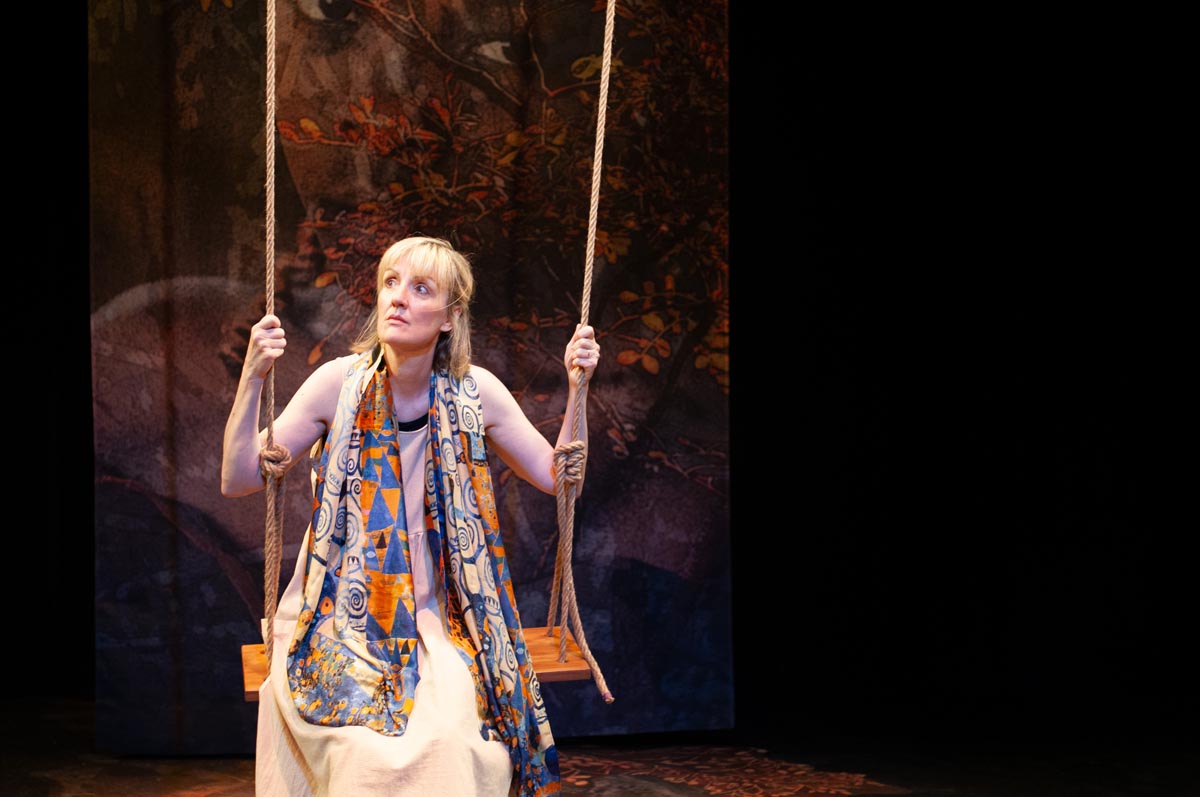
JAMES
Let’s talk a little bit about the play you’re currently in – The Syringa Tree. The play starts in 1963 and is told for a large part by Elizabeth a young child living with her parents in South Africa during Apartheid. It’s always an interesting choice to have a story told from a child’s perspective and I’m curious what you think having that viewpoint brings to the telling of the story.
KATHARINE
Well to begin with, the play is based on the playwright, Pamela Gien’s, experience as a child growing up in South Africa. Though most of the characters are fictional, they are shaped and informed by her life as a child. So, there is that somewhat autobiographical element to the choice of speaking the story through a child as Gien herself was a child growing up in South Africa during apartheid, and this is her story.
Also, the choice of telling this story through a child is a powerful way for an audience to connect to and empathize with the main character of the play, who is an innocent. Her naivety leads her to report what she sees, and she doesn’t judge or have the skills of an adult to fully process them. We see her experience and begin to work things out.
Lizzy is also an imaginative and emotionally open child, and so it’s fascinating to see into her world. We see her powerful love for her black nanny, Salamina, and Salamina’s child, Moliseng. And that relationship is at the very heart of the play.
The play is, in part, about family – two families who cross racial divides to bond with one another. Two mothers. Two children. And we see how their lives are intertwined even when living in a brutally divisive and dangerous apartheid society that actively and in the most authoritarian way seeks to divide them. In the telling of her story, Lizzy conjures up, as an imaginative child would do, the people who had a profound impact on her.
Having the main character as a child, also allows the play to gesture towards the invisible world of imagination, and then also to the invisible world of faith or the miraculous as moments of grace subtly break through into the characters’ lives at different moments in the story. The things we cannot see are given a part to play in this story.

JAMES
You’ve worked with Morris Ertman the director of the show many times before but this is your first time working out here in Rosebud. And in The Syringa Tree, you’re portraying over twenty different characters. So, I’m curious about a couple of things. First, how would you describe your working relationship with Morris and second, what was the process like as the two of you lifted this story from the page to the stage and brought it to life?
KATHARINE
It is always a gift for an actor to work with a director you know really well. Morris is just brilliant at so many aspects of directing. He understands narrative and identifies the heart of a story. He communicates very well with me and he understands me as an actor. He knows sometimes I just need to work out a moment and he gives me the space and time to do that.
He is rigorous and clear about keeping the acting “grounded” – that means finding the psychological and emotional and physical reality of a moment or scene and that it is a real gift to an actor when a director can articulate that so clearly and in a way that inspires. He is specific and he is very generous in filling out the thoughts and feelings of a moment so that it makes sense for the actor.
He can see when something isn’t clear and he was particularly insightful in this process at bringing a clarity to my flips between characters in an elegant way that also allows the story to spill out and gives the blocking – the movement of the piece – a real natural flow that one can follow and understand.
Morris is passionate about the telling of story in a way that is authentic and true to life, rewarding for an audience, and he does this with great kindness to his actor. And besides his deep understanding of the acting process, he also knows how to weave sound and lights within the acting moments so beautifully. That has been particularly powerful in this production where the sound and lights create a world that we can imagine and feel.
Morris also has a great sense of humour so we have good laughs too, and the rehearsal hall is a place where the rigour of our work gets done in a joyful way.
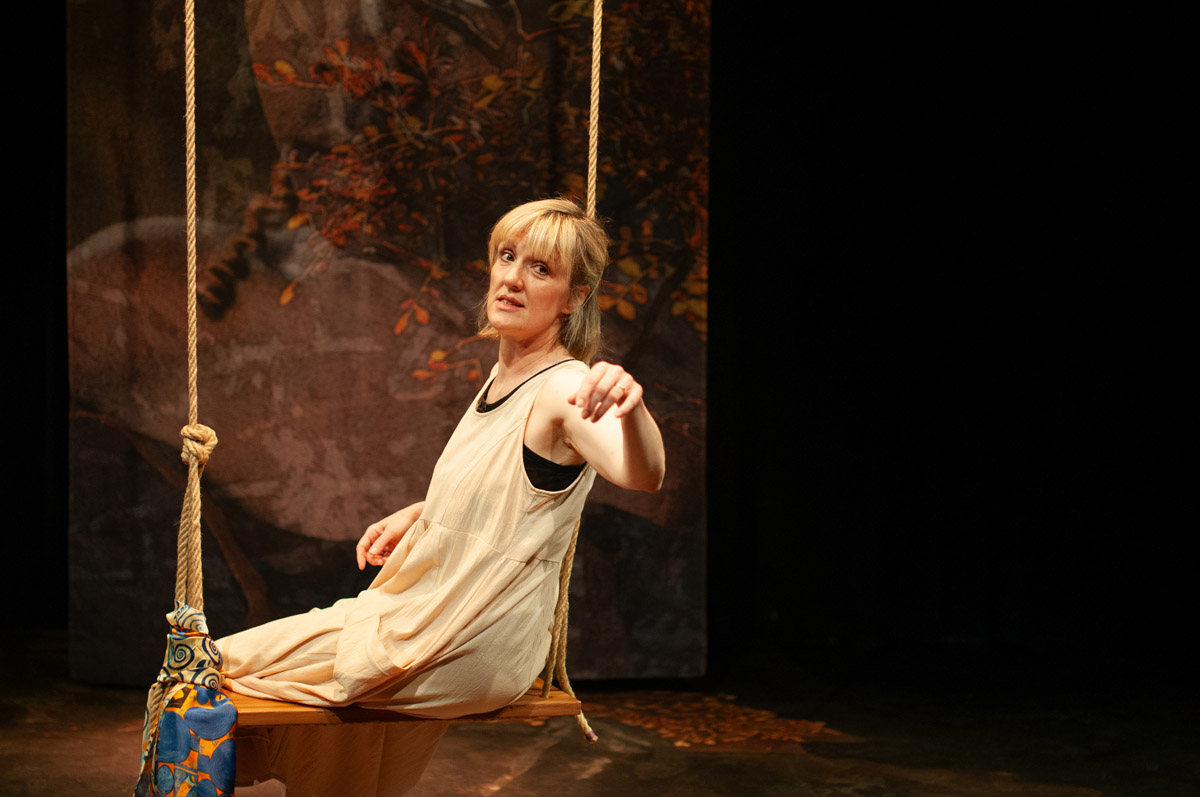
JAMES
I love small intimate theatre spaces like the Rosebud Studio Stage because I find these types of spaces are particularly compelling for telling stories. Small gestures and a change in voice or a moment of silence seem to have a bigger emotional impact since you’re not trying to reach the second balcony as you would in a large theatre space. How do you think the Studio Stage – lends itself to the telling of this story and this production of The Syringa Tree?
KATHARINE
Yes, I love intimate theatre spaces too – as an actor and an audience member. It allows for an intimacy between performer and audience member and that really serves this story. The smaller space gives the audience that wonderful experience of being very close to the performer and seeing every nuance – like a close-up in a movie. I’ve worked a lot on “alley staging” which is the stage formation for our production and where the audience sits on both sides of the playing space. I really like alley staging as it feels natural to me and allows me to use the whole space for movement as I’m working every side of the stage. It’s great for a one-person show as well as it provides a lot of visual variety for the audience.
JAMES
When we look at the story and its depiction of Apartheid, I think it not only shines a light on South Africa and its racial policies at the time but it makes us reflect in a bigger sense on Man’s tendency to oppress and divide throughout history. Every nation including our own has examples of these kinds of attitudes and behaviour. What do you think the story has to say about those aspects of humanity?
KATHARINE
Yes, humans dominating humans has certainly been a part of the history for many nations and it is good and healthy, though difficult, to reflect on that. But there are also examples throughout human history of moral frameworks which challenge bigotry, discrimination, and the will to dominate and instead encourage us to see all humans as integrally connected and valuable.
Christian scriptures, for example, teach that all humans are created in the ‘image of God’ and every human being has an inherent, intrinsic value that should be cherished and honoured. One of the commandments Jesus gave was to love one’s neighbour as oneself. The ancient South African philosophy of Ubuntu also shares this view of the interconnectedness of all human beings. According to Ubuntu philosophy, if a person hurts another person, they also hurt themselves. Systems like apartheid create a twisted and disturbed society that does not reflect what I see to be the fundamental human spiritual impulse towards love and connection – that ‘image of God’ planted in us.
The play reveals characters who struggle against division and oppression and towards loving relationships across racial lines. In that, it expresses something very deep and true about who we really are as humans and what we really long for in life, while not shying away from or minimizing the evil that we are capable of. The human spirit is strong, and I believe that when we acknowledge a power greater than ourselves – that is God – we can really live into our true calling by helping and loving others. And that way of being human aligns with the ‘image of God’ in us. For me, the play reveals that divine calling for humanity and in a haunting and beautifully subtle way gestures towards moments of grace and the invisible realm of the miraculous, as well as portraying the strength and perseverance of the human heart to overcome seemingly insurmountable obstacles.
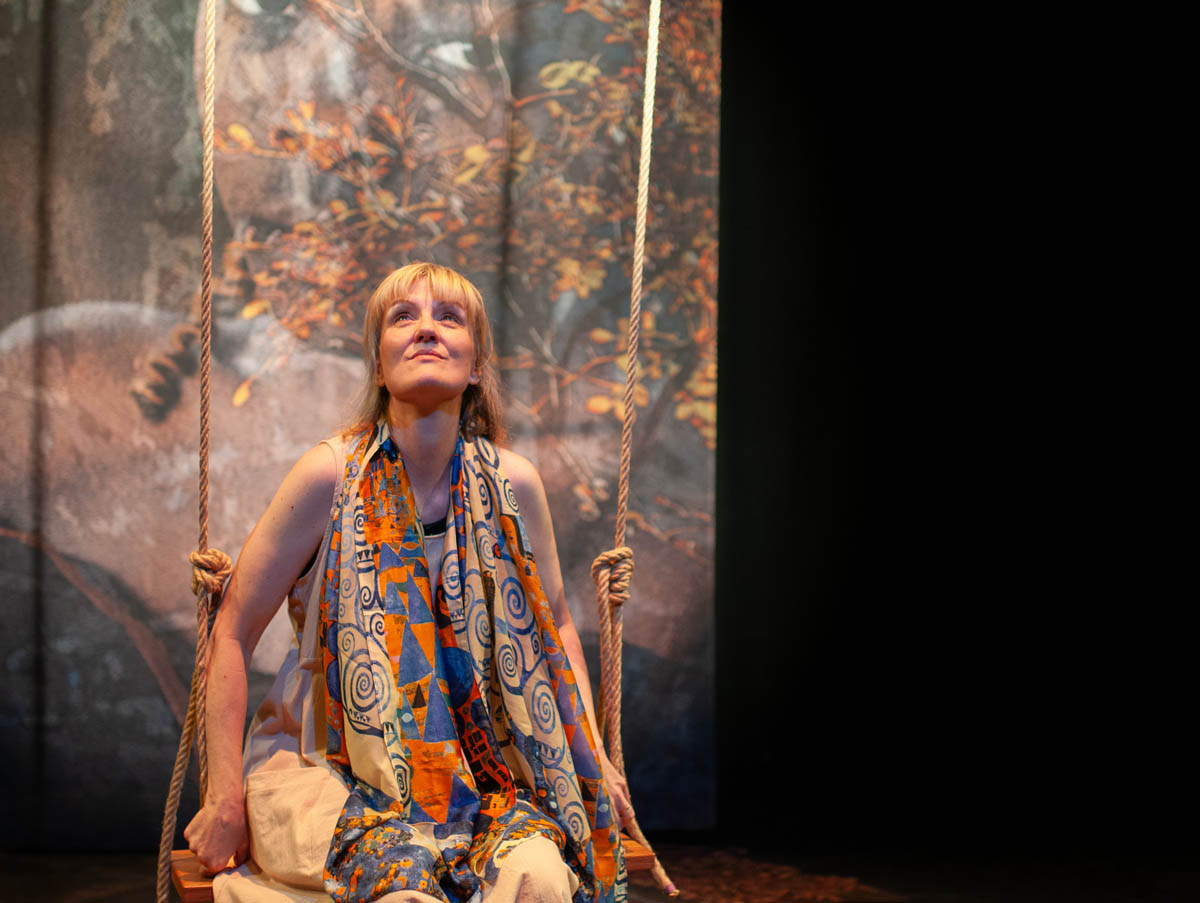
JAMES
You make your home in Vancouver now but you grew up in Calgary and lived in Priddis and went to the University of Calgary where you studied with Grant Reddick a well-known actor and teacher in the Calgary theatre community and so you have a history here – this was once home and so I’m wondering what’s it like to get a chance to perform on the Rosebud stage and share this story?
KATHARINE
It’s so lovely to be staying in Rosebud and performing in this beautiful play on their Studio Stage. It’s a one-woman show, but really I feel like the whole creative team is up there onstage with me. Luke Ertman has created an exquisite sound design and Brad Graham a beautiful lighting design and those elements of sound and lights feel like acting partners to me as they are so beautifully woven into the story by my director, Morris Ertman.
My costume is designed by Amy Castro and I love it as it moves with me through the portrayal of 22 different characters. The set I play on was built by Mark Lewandowski and scenic painter Cheryl Daugherty, creating an intimate space for me and the audience to explore the life of this play. My stage manager, Shannon Klassen, is the only other human who accompanies me on this journey, besides every member of the audience, and I am so grateful for her diligent and exacting work.

And then, of course, there is the playwright Pamela Gien whose words and wondrous story I am given to embody when I walk on stage. Theatre is always a collaboration of many artists, regardless of how many actors appear onstage, and I am so grateful to be surrounded by such gifted designers and artists here at Rosebud. The people of Rosebud are kind and hospitable, and it is also such a delight to be surrounded by the natural beauty of the land every day I walk to the theatre.
Vancouver has been home for me for 30 years now, and I have had beautiful professional opportunities there and great friendships. It is really wonderful to see my friends from Vancouver travel out to Rosebud to see the show – like two worlds – two homes – coming together.
And Alberta will always feel like home to me too. My husband and I and my two boys have travelled to Alberta every summer for the past 23 years to visit family. My parents spent 60 years of married life in Alberta. Both have died now – my Dad last Spring – so performing in Alberta this summer has a poignancy to it. I know my parents would be delighted that I am here on stage as they always supported my acting dreams and career. I have an enduring connection to Alberta.
I am forever grateful to my acting teacher and mentor, Grant Reddick, for his friendship and giving me such a strong and powerful foundation for acting when he taught me at the Theatre Department at the University of Calgary. He has been one of those people who has profoundly formed me.
This play is about home, as well as the deep bonds and influences that certain people have in one’s life and growth, so I resonate with that as I certainly feel the deep and loving influences of my parents, my family, my friends, my colleagues, and my teacher, Grant, in my life. The play also speaks to one’s connection to the land, and I feel that in Alberta. The prairies and the people of this province will always be a part of me.

